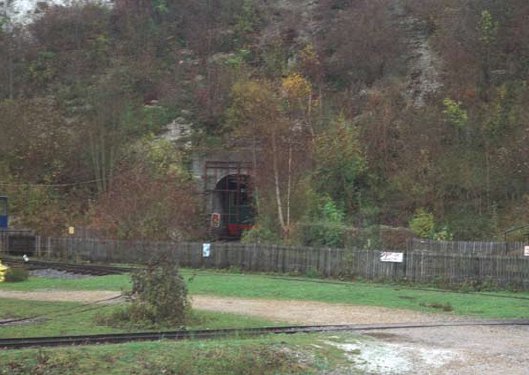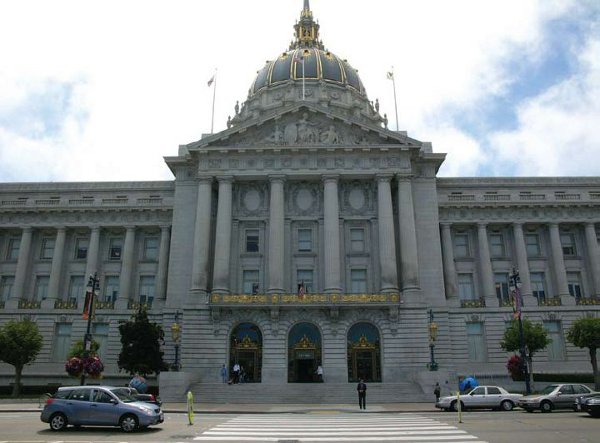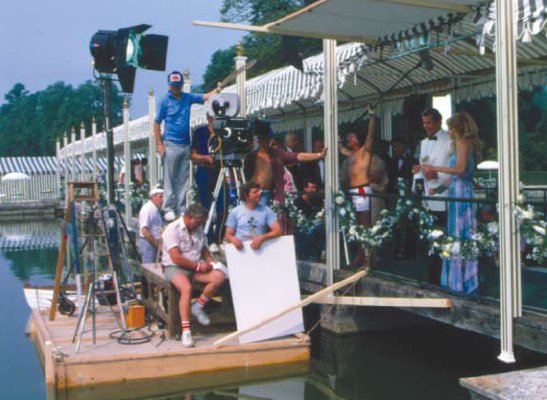Authors: Roger Moore
Bond On Bond (27 page)

Not quite California – Amberley Working Museum in West Sussex doubled for the mine where Zorin was going to trigger his dastardly plan of dominating Silicon Valley.
At the nearby Shiv Niwas Palace, a team of models were flown from England to partake in the obligatory poolside shoot and when the call went out to recruit some locals for extra work, we were inundated with thousands of people. Many had to be paid off just to leave, as we couldn’t have shot; in fact it became a daily occurrence for hundreds of onlookers to appear on set. The logistics of organizing crowd control during the stunt and chase sequences proved a bit of a challenge, and not always a successful one: the bicycle rider who broke up the tuk-tuk fight was not intended to be in shot at all, he was merely passing through.
The final Indian location was the Monsoon Palace, a striking building on the hillside of Udaipur, which became the lair of evil Kamal Khan.
Oh! And while we were on location, the first English-language film ever to screen at Udaipur’s largest cinema was
Moonraker
. They had good taste, I thought.

Checking the handbrake is on. The Nene Valley Railway stood in for East Germany in an exciting train sequence in
Octopussy
. It also doubled for Russia in
GoldenEye
!
A View To A Kill
thankfully avoided the heat of India and Thailand and instead took us to Paris, Chantilly and, of course, San Francisco. At the end of the working day, we had somewhere to go and eat in comfortable surroundings and didn’t have to worry about what we were eating!

We filmed the climax to
A View To A Kill
on the Golden Gate Bridge. Here my brave stunt double Martin Grace climbs up to the top, some 227 metres above the water.
The snowy opening in Iceland was filmed by the second unit, and I was cut in with pick-up shots at Pinewood before we all headed to Royal Ascot, and then on to Staines for the scene in which Bond and Stacey enter the Zorin mineshaft, along with the Amberley Chalk Pits Museum in West Sussex, which both doubled for California.

Whereas I filmed my close-ups on a Pinewood set out on the backlot, just a few metres above the ground.
When San Francisco was touted as a filming location, Cubby sought the necessary permissions from the Mayor’s office – the Mayor at that time being Diane Feinstein – explaining they’d like to set City Hall on fire, stage a chase with a fire engine through the streets, and film the climax on top of the Golden Gate Bridge. The response was not particularly positive.

City Hall, San Francisco. Our special-effects team carefully laid smoke pots and started controlled fires on parts of the exterior. I believe we were one of the few film crews, if not the only one, ever allowed to wreak such havoc with the full blessing of the Mayor.
‘Who is playing Bond?’ Mayor Feinstein asked.
‘Roger Moore.’
‘Roger Moore? Ah! I like him,’ she replied. ‘What can I do to help, Mr Broccoli?’
The only caveat to our filming atop the bridge was that there couldn’t be any fighting – there could be a bit of a struggle, but no out-and-out fight. My brave stunt double Martin Grace climbed to the top of the bridge – after earlier holding onto the guy rope of the airship as it crossed the harbour – to perform the final tussle, while part of the bridge was then reconstructed on the Pinewood backlot for me to film my close-ups, looking very brave.
There were even mightier heights to climb, as in Paris it was planned that B.J. Worth would film a parachute jump off the Eiffel Tower, after I had chased Grace Jones up most of it. Curiously, while permission had been granted for the jump, as the landing was going to be on a boat cruising down the Seine, that came under a different authority, and at first they refused permission: we could jump, but couldn’t land. However, eventually all was smoothed over …
Of course, I must also pay homage to the home of 007 and indeed my second home, Pinewood Studios. I shot all of my films – except
Moonraker
– out of Pinewood, and have a huge affection and appreciation for the studio. For many years my office was right next door to Cubby’s, and I’d like to think we were good neighbours. Now Barbara and Michael occupy Cubby’s office and the tradition continues. The studio has featured extensively in the films – Goldfinger’s factory was the studio ‘covered way’ on the lot; the opening shots in
From Russia With Love
were filmed in the gardens; in
The World Is Not Enough
villainous Reynard hid away in the Pinewood pond grotto; the Ice Palace exterior in
Die Another Day
was all built on the backlot; and, of course, the huge volcano set in
You Only Live Twice
stood next to the present site of the 007 stage and could be seen from miles away. Pinewood and Bond are linked very closely, and hopefully will be for many years to come.
Of course, since my time Jimmy has ventured to all manner of new interesting places outside the studio walls; in particular, behind the Iron Curtain and Eastern Blocks. Where will he go next we ask? Well,
Skyfall
was rumoured to be returning to India, but then switched to Turkey instead, where the action sequences could be better accommodated. There were also rumours abound about South Africa and China.

On location in Chantilly – it may just be two of us in shot, but a lot goes on behind the camera!
One thing is for sure: when the phone rings next and a voice says, ‘I’m working for Eon Productions and would like to talk about shooting the next Bond film in your country …’ they’ll be greeted with open arms.

_______________________
_______________________

George Lazenby, Timothy Dalton and me at the BAFTA fortieth anniversary tribute. I guess that makes us 00-21.
I
’m often asked, ‘who is the best Bond?’
‘Apart from myself?’ I modestly enquire. ‘It has to be Sean.’
Sean
was
Bond. He created Bond. He embodied Bond and because of Sean, Bond became an instantly recognizable character the world over – he was rough, tough, mean and witty. Of course, it was an alter ego he didn’t always appreciate, but it was one I’d like to think he is ultimately proud of – as he was a bloody good 007.

Harry, Sean, Diane Cilento and Cubby photographed just after Sean signed his multi-picture Bond contract in London.
I first met Sean in the early 1960s at Arlington House in London, at a reception hosted by actress Binnie Barnes and her husband, film producer Mike Frankovich. Sean was there with his then wife Diane Cilento. Apart from his imposing size, the things I remember most from that first meeting were his amazing eyes. I’m happy to say that our meeting at that party marked the start of a friendship that goes on to this day.
It’s no secret that, after
Thunderball
, Sean was becoming disenchanted with the films. He’d helped establish the character internationally and everywhere he went there was merchandise with his image on it. However, he wasn’t receiving any extra remuneration and what with that, the constant media attention and the pressure of being Bond causing a rift in his marriage, he obviously felt that no one part was worth all this.
Terence Young told the producers, ‘Take Sean as a partner, make it Cubby, Harry and Sean. Sean will stay with you because he’s a Scotsman. He likes the sound of gold coins clinking together. He likes the lovely soft rustle of paper. He’ll stay with you if he’s a partner, but not if you use him as a hired employee.’

A very youthful looking Sean in one of his first publicity shots for
Dr. No
.
Cubby and Harry didn’t want another partner at Eon, and so Sean announced
You Only Live Twice
would be his last appearance as 007. At the Royal Charity premiere, even Her Majesty the Queen asked him, ‘Is this really your last James Bond film?’
‘I’m afraid so, Ma’am,’ he told her.
Though Harry and Cubby reportedly offered Sean just under a million dollars to appear in
On Her Majesty’s Secret Service
, he turned it down.
Thinking he might take advantage of Sean’s disenchantment after
Thunderball
premiered, Charles Feldman, who had acquired the film rights to
Casino Royale
, tried to interest Sean in starring in his movie. Feldman had intended it as a thriller but when Sean declined Feldman abandoned the idea and turned it into a comedy instead. With seven directors and numerous writers, it ended up a confusing mess and a box office disaster, despite featuring David Niven as Sir James Bond and an incredible cast including Ursula Andress, Peter Sellers, Woody Allen, Orson Welles, Deborah Kerr, William Holden and John Huston.

Twenty-one years after
Dr. No
, Sean returned in
Never Say Never Again
; a title coined by his wife Micheline after he famously quit the role in 1971, vowing never again.
On Her Majesty’s Secret Service
did respectable business at the box office without Sean, but George Lazenby made it clear that it was his one and only appearance as 007. United Artists were desperate to keep their cash cow on track, and David Picker – president of United Artists – met with Sean to agree a return for
Diamonds Are Forever
. American actor John Gavin had been in the frame and was offered a multi-picture contract, but a week before filming started Sean agreed to take on the role once more and Gavin was paid off.
Sean had been made an offer he simply couldn’t refuse: David Picker had guaranteed him $1¾ million, plus a percentage of the profits, and agreed to provide financial backing for two films of Sean’s choice.
Sean was then reputedly offered $5 million to return to Bond in
Live And Let Die
, but refused saying, ‘Never again’. I’m very grateful to him – and, of course, work cheaper too.
But another story was forming in the wings. With his ten-year restriction over, Kevin McClory began to make plans to rework the
Thunderball
plot for the screen again.


The press like to stir things up, and the ‘Battle of the Bonds’ was good headline material; that and poking fun at our advancing ages.
He engaged Len Deighton as his co-writer on the project,
James Bond Of The Secret Service
, and secured backing from Paramount Pictures. Then, in what was to prove a masterstroke, he approached Sean to become involved in the screenplay. Who knew the character better than Sean?
Sean agreed and relished his new creative role.
‘The three of us did a screenplay and put all sorts of exotic events in it,’ he said. ‘You remember the aircraft that were disappearing over the Bermuda Triangle? we had SPECTRE doing that. There was also this fantastic fleet of planes under the sea – and they were going to be used to attack the financial centre of New York by going through the city’s sewers – which you can do – right into wall Street.
‘There were going to be mechanical sharks in the bay, a take-over of the Statue of Liberty and the main line of troops on Ellis Island. All that sort of thing.’
The title changed to
Warhead
.
There was a rumour Sean would play Bond, with Orson Welles as a villain and Trevor and Paramount pulled out of the venture.
The flurry of news as reported in the trade journals brought the fact that Sean was now involved to the attention of Jack Schwartzman, executive vice president of Lorimer and husband of Talia Shire – with whom I made a film called
Bed And Breakfast
.
He raised the money required from twenty-five independent backers and restricted the plot back to that of
Thunderball
, thus avoiding any further legal complications.
Once Sean had written the script, he started to care about the character he’d previously tired of. By this time, Sean had divorced Diane and married his second wife Micheline, who, having heard the rumours of his return as Bond, asked that if he was enjoying it so much, why not play the part again? Adding he should never say never again … which, of course, became the title.
There were various legal issues still to be resolved, not least Cubby Broccoli’s lawsuit over the filmic ownership of 007, which was eventually agreed out of court and which gave Cubby a percentage of the
Never Say Never Again
box office.
Sean’s film swung into production at Elstree Studios around about the same time as I started shooting
Octopussy
at Pinewood. The press made a splash about our going head to head, with both aiming for a summer 1983 release.
Never Say Never Again
in fact opted for a Christmas release so as not to split the summer audience. I met Sean occasionally for dinner in London during shooting, and still do to this day. He’s a very talented actor, and outside of Bond has turned in some fun, impressive and lucrative performances. It’s a shame we never got to do one together.
